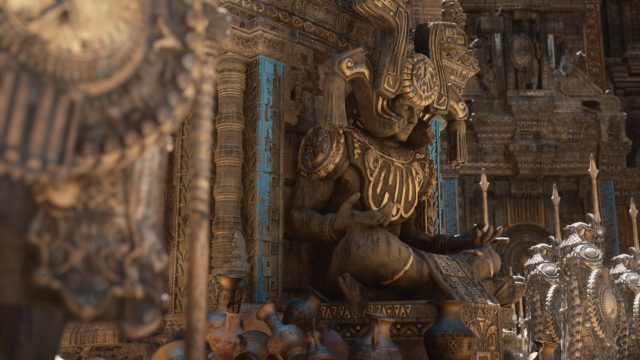Unreal Engine 5 Oculus Quest 2
This week Epic Games released the latest version of its next-gen game engine, Unreal Engine v. Though the new version brings improvements in many areas, its virtually notable features are Lumen (global illumination) and Nanite (micro-polygon geometry), which could exist game-changers for VR immersion. Unfortunately the company says neither feature is prepare for VR developers.
Available equally of this week for all developers, Unreal Engine five promises to conductor in a new era of game development which makes it easier for developers to create games with extremely high quality assets and realistic lighting. That's thanks to the engine's two new central features, Nanite and Lumen.
Nanite
Nanite is what Epic calls a "virtualized geometry" arrangement which radically improves the geometric particular in game scenes.

Previously developers would create loftier quality 3D models every bit a sort of 'master' reference which would eventually have their geometry greatly simplified (leading to a reduction detail and complication) before being pulled into the game engine. The same model generally gets several versions with increasingly reduced particular which 'pop' between each other depending upon how far the game photographic camera is away from the model (known every bit 'level of detail' or 'LOD'). This allows the game to show higher quality upward close while using the reduced quality models when they are farther abroad to salve performance.
Nanite essentially functions like a continuous LOD system that draws particular from the original 'chief' model, instead of relying on pre-built models with reduced particular. In each frame the organization references the master model and pulls out the maximum level of detail needed for the given photographic camera distance. Not only does this eliminate the need to create discrete LOD models, information technology besides means that the range of detail for a model tin can be much greater, allowing players to see incredibly fine detail—right downwards to the original polygons of the 'master' model—if they go close enough.
Lumen
Meanwhile, Unreal Engine v'south new lighting system, Lumen, greatly simplifies game lighting cheers to global illumination.

Realistic lighting can exist very computationally expensive; without Lumen, many games utilise a combination of lighting techniques to achieve the await they desire while maintaining game performance. A given scene might use pre-calculated 'broiled' lighting (which isn't interactive with the rest of the scene) forth with a small number of real-time light-sources that cast shadows on certain objects in the scene, and various 'screen-space' effects to emulate realistic lighting.
Lumen unifies lighting into a unmarried arroyo called global illumination, which aims to make every light in the scene—even the Lord's day—into a real-time light that is interactive with other lights and the rest of the scene. This includes realistic bounced calorie-free which spreads colour throughout the scene based on the color of the objects that the light hits. For example, white sunlight shining into a white room with a red floor will cast some red lite onto the walls as it bounces from the cerise floor. Such bounced lighting is an essential component of photo-real lighting.
Both Nanite and Lumen could massively amend immersion in VR thanks to their ability to hugely increment geometric detail in nearby objects (which is especially noticeable with the stereoscopic capability of VR headsets) and to create more realistic and interactive real-time lighting.
"No Timeframe" for Nanite or Lumen in VR
Unfortunately Epic says that neither Nanite nor Lumen in UE5 are ready for VR yet.
"While nosotros take no timeframe to share in terms of Lumen and Nanite support for VR experiences, we are exploring how to bring those UE5 features to additional platforms," the company tellsRoad to VR.
But, Epic says, that doesn't mean VR developers shouldn't utilize UE5.
"VR developers can leverage most of Unreal Engine 5's production-fix tools and features, such as the new UI, the new suite of modeling tools, creator tools such every bit Control Rig, MetaSounds, and World Partition for big open up environments."
What's the Holdup?
Though both Nanite and Lumen are capable of creating incredible looking scenes, they aren't 'free' from a performance standpoint.
"Although the advantages [of Nanite] can be game-changing, there are practical limits that withal remain. For example, case counts, triangles per mesh, material complication, output resolution, and performance should exist carefully measured for whatsoever combination of content and hardware," the visitor warns developers. "Nanite will continue to expand its capabilities and meliorate performance in hereafter releases of Unreal Engine."
Lumen, meanwhile, is simply designed to target 60 FPS for large outdoor scenes and xxx FPS for indoor scenes on the very latest console hardware. That's a far cry from the xc FPS minimum for most PC VR headsets. And with Quest 2 being significantly less powerful than the latest consoles, there'due south just no way it'll be able to handle those kinds of demands. Which may mean that the ultimate limitation in bringing these features to VR is simply operation (or lack thereof).
The aforementioned scene rendered for a flat screen compared to being rendered for VR is often less performant in VR due to the demand for stereoscopic rendering (and usually higher resolutions). Tricks like single-pass stereo and foveated rendering help reduce this overhead, just may not yet work in conjunction with the likes of Nanite and Lumen.
Then it may be matter of optimization and more powerful hardware before it's practical to bring these features to VR experiences. From Ballsy'due south perspective, Unreal Engine has just a small fraction of VR developers compared to the likes of the Unity engine, on which the vast majority of VR games today are congenital. Especially with the trajectory of Meta'southward Quest ii as the most popular target platform for developers (and its lack of ability compared to consoles and PCs), it seems likely that optimizing Nanite and Lumen for VR is very low on Epic's priority listing.
Hopefully nosotros'll meet these adjacent-gen engine features in VR eventually, but it might not happen for some time yet.
Source: https://www.roadtovr.com/unreal-engine-5-release-nanite-lumen-vr/

0 Response to "Unreal Engine 5 Oculus Quest 2"
Post a Comment